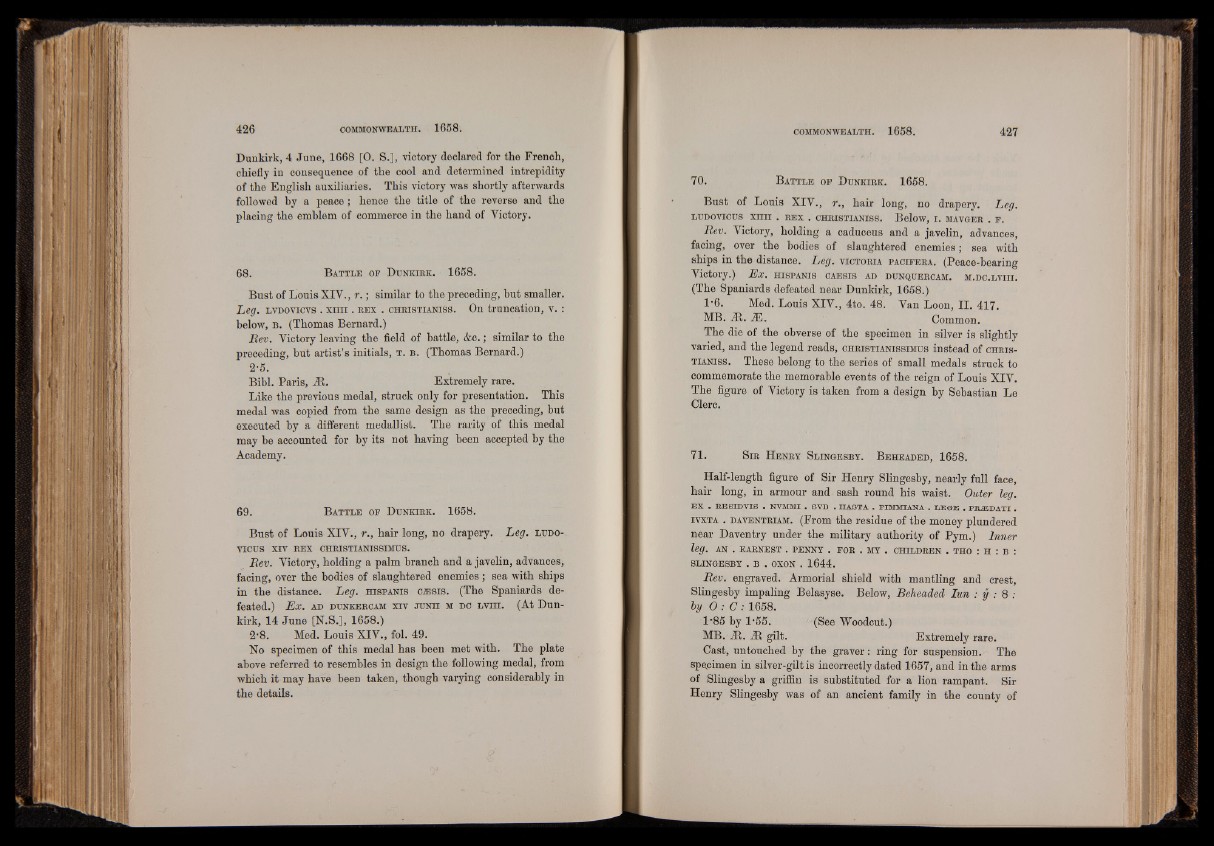
Dunkirk, 4 June, 1668 [0. S.], victory declared for the French,
chiefly in consequenoe of the cool and determined intrepidity
of the English auxiliaries. This victory was shortly afterwards
followed by a peace; hence the title of the reverse and the
placing the emblem of commerce in the hand of Victory.
68. B a t t l e o f D u n k ir k . 1658.
Bust of Louis XIV., r. ; similar to the preceding, but smaller.
Leg. lvdovicvs . xim . r e x . c h r is t ia n is s . On truncation, v. :
below, b . (Thomas Bernard.)
Rev. Victory leaving the field of battle, &c. ; similar to the
preceding, but artist’s initials, t . b . (Thomas Bernard.)
2-5.
Bibl. Paris, At. Extremely rare.
Like the previous medal, struck only for presentation. This
medal was copied from the same design as the preceding, but
executed by a different medallist. The rarity of this medal
may be accounted for by its not having been accepted by the
Academy.
69. B a t t l e o f D u n k ir k . 1658.
Bust of Louis XIV., r., hair long, no drapery. Leg. lu d o -
VICUS XIV REX CHRISTIANISSIMUS.
Rev. Victory, holding a palm branch and a javelin, advances,
facing, over the bodies of slaughtered enemies ; sea with ships
in the distance. Leg. h i s p a n i s CM3IS. (The Spaniards defeated.)
Ex. a d d u n k e r c am x i v j u n i i m d c l v h i . (At Dunkirk,
14 June [N.S.],; 1658.)
2-8. Med. Louis XIV., fol. 49.
No specimen of this medal has been met with. The plate
above referred to resembles in design the following medal, from
which it may have been taken, though varying considerably in
the details.
70. B a t t l e o f D u n k ir k . 1658.
Bust of Louis XIV., r., hair long, no drapery. Leg.
LUDOVICUS XIIII . REX . CHRISTIANISS. Below, I . MAVGER . F.
Rev. Victory, holding a caduceus and a javelin, advances,
facing, over the bodies of slaughtered enemies; sea with
ships in the distance. Leg. v ic to r ia pa c íf e r a . (Peace-bearing
Victory.) Ex. h is p a n is c a e s is ad dun q uer cam . m.d c .l v i i i .
(The Spaniards defeated near Dunkirk, 1658.)
1'6. Med. Louis XIV., 4to. 48. Van Loon, II. 417.
MB. ¿R. iE. Common.
The die of the obverse of the specimen in silver is slightly
varied, and the legend reads, c h r is t ia n is s im u s instead of c h r is t
ia n is s . These belong to the series of small medals struck to
commemorate the memorable events of the reign of Louis XIV.
The figure of Victory is taken from a design by Sebastian Le
Clerc.
71. S ir H en r y S l in g e s b y . B e h e a d e d , 1658.
Half-length figure of Sir Henry Slingesby, nearly full face,
hair long, in armour and sash round his waist. Outer leg.
EX . RE SID VIS . NVMMI . SVB . HASTA . PIMMIANA . LEGE . PREDATI.
iv x ta . d a v en tr iam . (From the residue of the money plundered
near Daventry under the military authority of Pym.) Inner
leg. AN . EARNEST . PENNY . FOR . MY . CHILDREN . THO : H : B :
SLINGESBY . B . OXON . 1644.
Rev. engraved. Armorial shield with mantling and crest,
Slingesby impaling Belasyse. Below, Beheaded Iun : y : 8 :
hy 0 : 0 : 1658.
1-85 by 1-55. (See Woodcut.)
MB. At. At gilt. Extremely rare.
Cast, untouched by the graver: ring for suspension. The
specimen in silver-gilt is incorrectly dated 1657, and in the arms
of Slingesby a griffin is substituted for a lion rampant. Sir
Henry Slingesby was of an ancient family in the county of